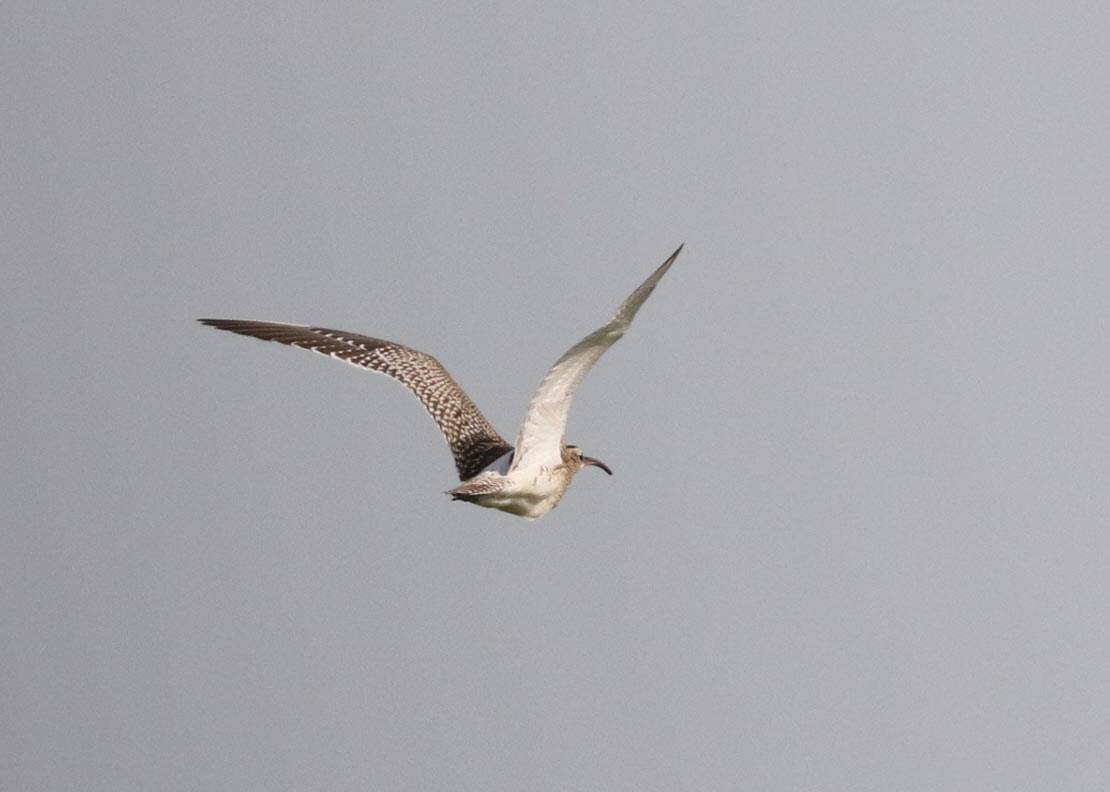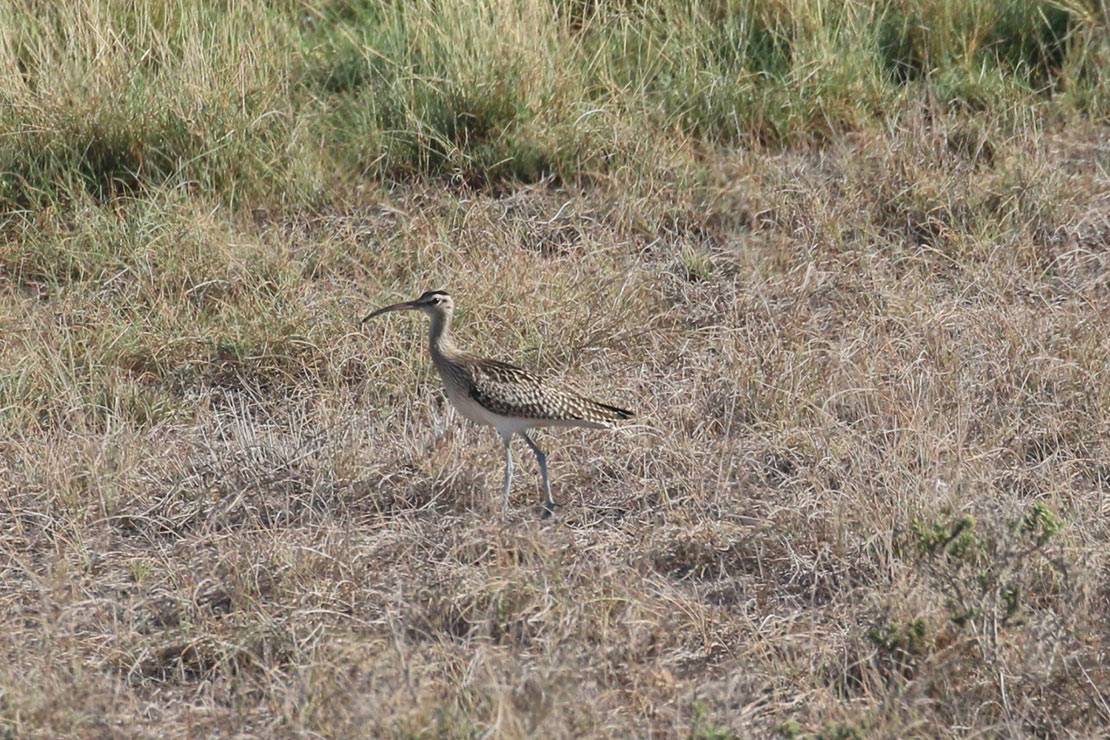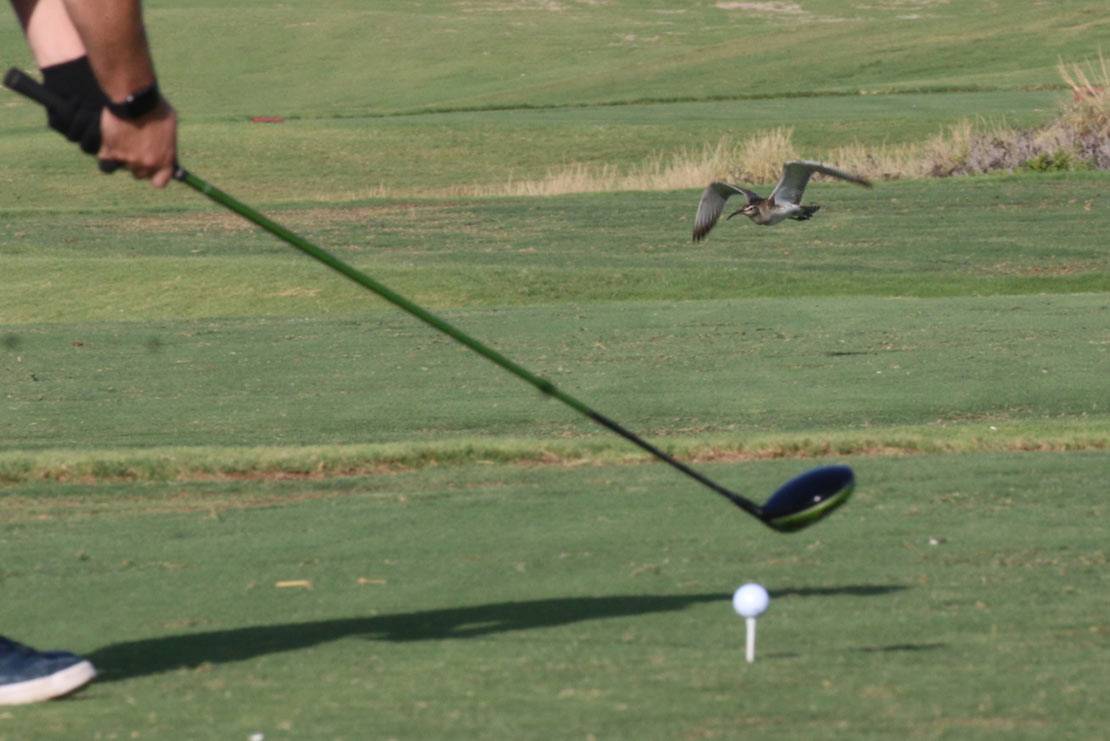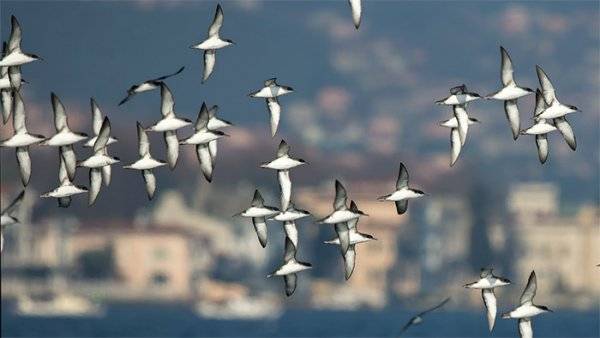Guest blog by Oscar Campbell – with thanks to Simon Lloyd

The start of it all. It was this image that really got us thinking seriously that we might, at last, have got the cigar. The underwing is stunningly white and very clean in this shot, the flank spotting limited in extent and the fine breast streaking ends on the upper breast. Photo by Simon Lloyd.
To many, shorebirds epitomize the enigma and marvel of long-distance migration, spanning the planet as globe-trotting wanderers. I first pored over the plates of Hayman, Marchant and Prater’s epic volume (see 1) in 1988 as a school kid in Ireland, and still do each year I return home, my copy currently safely stored there (alongside Harrison’s Seabirds and, of course, Porter et al’s Flight Identification of European Raptors…). Living in the UAE, I am routinely treated to more shorebirds than I could ever possibly have dreamt about whilst cycling around inland Ireland, and can quite easily find almost 20 species within minutes of home, or up to 30 on venturing further afield, some from as far away as Kamchatka (see 2). I record itinerant nocturnal Crab Plover flocks flying over my balcony in Abu Dhabi annually (including, funnily enough, two hours after I drafted this first paragraph!) making me wonder why, back in Ireland each August, I cycle out from my parent’s house to look for Icelandic Black-tailed Godwits and Scandinavian Ruff stopping on migration along the shores of Lough Neagh. But I still do…
For approximately 100km2 of concrete, Abu Dhabi Island is a surprisingly good place to look for migrating birds and those, of course, include shorebirds. Plenty of them! On the shallow Arabian Gulf shoreline, we are surrounded by vast areas of intertidal mud and mangroves that still harbor good populations, despite industrial development and inevitable dredging. Over 15 years I have accumulated 43 species of shorebirds here, including four Numeniini, a group of spectacular large waders that, globally are in serious trouble (see 3). Given the inaccessibility of much habitat, there is still much to learn, as witnessed by the discovery of wintering Great Knots 2km from home in January 2020. Or the Broad-billed Sandpipers that occasionally appear (up to 100 at a time!) only to just as suddenly vanish.
Another way of sampling shorebirds in and around Abu Dhabi Island is to find them when they appear at sub-optimal but more accessible sites. This tactic works best during autumn migration (mainly September) when naive juveniles, newly arrived but, perhaps, excluded from richer intertidal habitats by dominant adults, are desperate for anywhere offering safe roosting and feeding. Saadiyat Beach Golf Club, situated on the north-eastern edge of Abu Dhabi Island, reigns supreme for such sightings and, at the Golf Club’s invitation, Simon Lloyd and I have surveyed birds there since September 2017. The site list has now reached over 180 species, including 37 shorebirds (see 4). Since the discovery of wintering Steppe Whimbrels in Mozambique in February 2016 and the subsequent pioneering work of Gary Allport, drawing attention to this little-known taxon (see 5 and references therein; also see 6 and 7), Simon and I routinely check Whimbrel underwings anywhere and everywhere in the UAE, resulting in us pestering Gary on several prior occasions with birds that, at least initially, rang alarm bells. One such bird, seen actively migrating well offshore in July 2019, featured in the Around the Region section of Sandgrouse 40(2).
During a visit on 28 August 2020, Whimbrel numbers were relatively high, as is typical for early autumn. Towards the end of that steamy morning, another pale and very clean pair of underwings alerted Simon and a closer approach gave us good telescope views and, eventually, the all-important underwing, tail and rump shots. These looked promising but with the bird flying and the course getting busier and busier with more legitimate cliental than us (i.e. golfers!), we couldn’t pursue it further. However, going back over our images and the literature at home, we soon realized we would need to call in expert advice. Again!

Another shot showing the underwing, but note also that the rump and uppertail appear to be scarcely marked; a few small spots on the latter are shown by some specimens of Steppe Whimbrel whilst shadow on the upper rump suggests that the apparent lack of streaking there is real and not an artefact of over-exposure. Shooting RAW images and deliberating under-exposing can help to determine the exact details of the axillaries and rump. Photo by Simon Lloyd.
Gary responded both promptly and positively, giving an initial thumbs up and, a day later, a detailed breakdown of field characters. It was only then that the enormity of what we had found started to sink in. Aging the bird in the field was easy on plumage condition and yes, there really were no other field observations of juveniles. Anywhere in the world! Ever! This was a bird we just had to find again but searches the next two afternoons drew blanks. However, a search on the morning of the 4 September was soon successful and we then spent well over hour observing and photographing this subtle, enigmatic bird. Now, finally, we could properly enjoy ourselves, with an ultra-rare shorebird just metres away. Both Simon and I were just a bit too young to have done anything about seeing those last Slender-billed Curlews as they dwindled away in Morocco in the early 1990s; I guess this was as close as we will ever get.

Aging is easy, even at a distance, on account of the very neat, evenly aged wing feathers. In this images the bird’s looks very clean and pale with the streaking ending finely high on the breast. The wings are longer than on many (but not all!) nominate Whimbrels, with primaries falling only fractionally short of the tail tip. Photo by Oscar Campbell.
We had already informed the Golf Club about what they were hosting and, on that second morning we met up to explain more exactly. They were as excited and pleased as us (well, almost…!) and agreed that that this could be a great positive news story for the local press, something that has been few and far between in 2020. The result was a detailed story in The National, the UAE’s leading English newspaper (see 8; also 9), which was soon picked up and covered by many other local media channels, including CNN’s Arabic channel, whilst social media took the story as far afield as China and North America. The golf club released their own press statement, going so far as to get a reaction from no less than Gary Player, the course designer (see 8). In some ways, the UAE is an appropriate location for a Steppe Whimbrel to break its southward migration. Of course, Abu Dhabi is the home of the Mohammed Bin Zayed Species Fund, which recently provided funding to University of Cape Town (led by Professor Peter Ryan and Gary Allport) for a project to satellite-track Steppe Whimbrels from Mozambique to their southern Russian breeding grounds. Further, Saadiyat Beach Golf Club, like the other local courses managed by Troon Golf, work hard to manage their land in a manner that makes them as attractive to resident and passing birds, and other wildlife, as possible. In three years of visits, Simon and I have enjoyed some terrific birding, but we are unlikely to quite match the excitement and significance of this discovery again. The site’s (and Abu Dhabi Island’s) first Baillon’s Crake a few weeks later really didn’t matter!

Many migrant shorebirds at Saadiyat, and other golf courses in the UAE, quickly become used to people even during a short stopover and, consequently are much more approachable than they would ever be on intertidal habitats. Photo by Oscar Campbell.
Acknowledgements
Simon Lloyd and I would like to thank all staff at Saadiyat Beach Golf Club, in particular Clinton Southorn, Corey Wade Finn and Bryan Cox, for facilitating our frequent visits. We are also very grateful to the local golfers who cheerfully tolerate us. Many thanks to Gary Allport for much patient advice and encouragement, over several years, in our quest for a Middle Eastern Steppe Whimbrel and to Peter Hellyer for help in the field and with making sure that the local media both got wind of the story, and then reported it correctly! Richard Porter also gave much encouragement and advice with regard to this article.
Oscar Campbell

Oscar Campbell and Simon Lloyd are long-term residents of the UAE and both currently serve on Emirates Bird Records Committee. They both teach Chemistry and Physics respectively at a school in Abu Dhabi.
References / Links:
1 https://www.thaibirding.com/book_reviews/shorebirds.htm
3 https://wadertales.wordpress.com/2017/03/01/why-are-we-losing-our-large-waders/
4 https://ebird.org/hotspot/L1456477
5 https://osme.org/2018/03/finding-steppe-whimbrels-in-the-middle-east/
6 https://www.waderstudygroup.org/article/11936/
10 https://www.troon.com/rare-bird-sighting-at-saadiyat-beach-golf-club-in-abu-dhabi/


